In this guide, I’m taking you to the small town of Potsdam that King Frederick II made great. Although it sounds like a cute, drowsy hamlet, everyone is amazed by the rich cultural and political heritage of this place where Europe’s history was written and re-written again.

Which Frederick? you might ask rightly so. Well, actually there was a couple of them.
The most popular was certainly Frederick II, aka Frederick the Great. But let’s start with his father, Frederick William I.
Frederick William I
Born in 1688 in Berlin, Prussian King Frederick William I incorporated all the famous and also rather infamous virtues and quirks that Germans are said to have until this date.
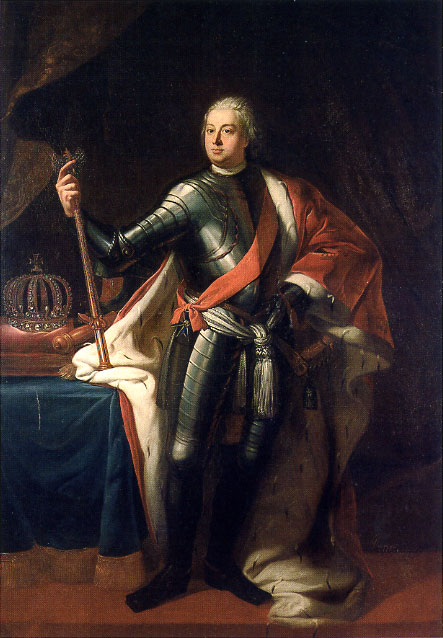
(Illustration:Samuel Theodor Gericke, Friedrich Wilhelm I 1713, public domain, details on Wikimedia Commons)
He was very rigid, absolutistic, sparing, and meticulous. My tour guide in Potsdam cleverly remarked that he would have just loved the invention of the Excel sheet. He had enlisted even every little piece of stationary in long columns.
And he was totally military-buff and basically made Potsdam into a garrison town.
They did not call him the Soldier King for no reason.
But you actually have to give him credit for implementing compulsory schooling and promoting trades such as wool and textile industry. Whereby this is what basically all these dictators do.
With his wife – and cousin! – Sophia Dorothea of Hanover, a sister of King Georg II of England, he had 14 children. Frederick II being the most famous one.
His cousin! Gosh, I’m glad that these aristocrats are marrying some random Hollywood starlets nowadays.
Frederick II
Frederick II was born in 1712 – and I cannot stretch this point enough: on January 24 – just like me….and Neil Diamond.

(Illustration: Anton Graff, Friedrich Zweite Alt, public domain, details on Wikimedia Commons)
He was a pretty different character than his daddy and he had quite different ideas of how to rule a country. He led Prussia into the three Silesian Wars, the last being the Seven Years’ War. Nonetheless, his leadership style was based on the ideas of the Enlightenment movement.
He was a pen pal with Voltaire, played the flute – at the age of 26 he composed his first symphony. He admired rococo painters such as Watteau and had a circle of artists friends.
And he did not fool around with the ladies.
His father was not happy.
Do you remember the movie Billie Elliot – I can dance? It was a bit like that (come on, you history teachers, it’s a joke!).
Only after Frederick II agreed to marry Elisabeth Christine of Brunswick-Wolfenbüttel-Bevern (good for her that at that time they did not have to print names on credit cards), things between him and his father got a bit better. The marriage, by the way, remained childless since Frederick was sterile due to some STD he caught only he knows where.
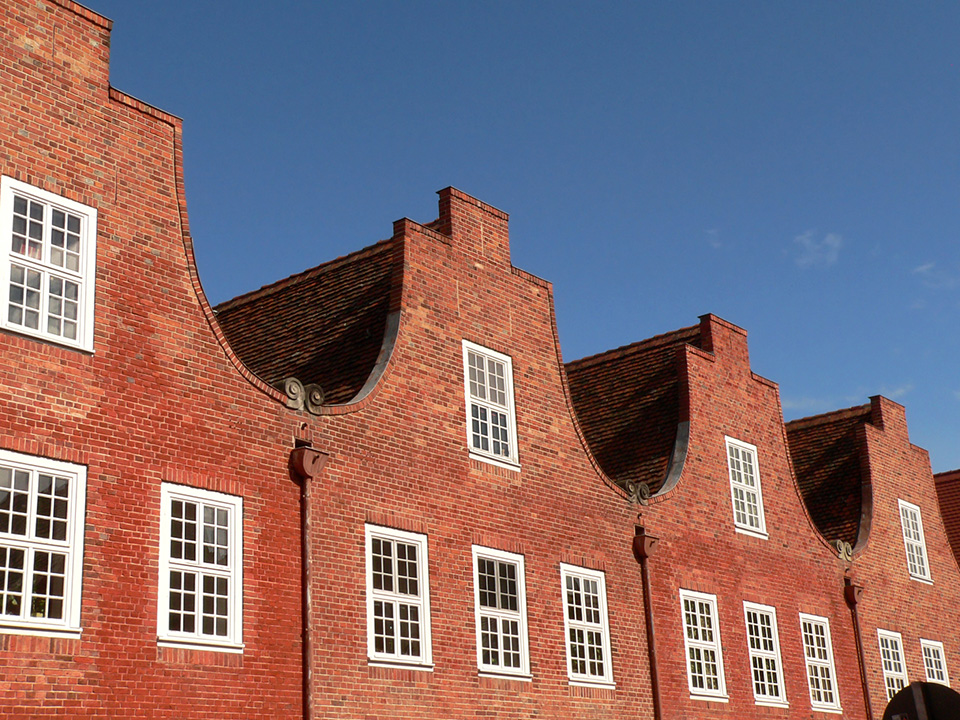
(Photo: Axel Hindemith, Potsdam hölländisches Viertel Giebel, CC BY-SA 4.0)
Good Deeds
However, he was by far not just an idle layabout. He brought industries such as silk farms and porcelain manufacturers to Potsdam and was the first to introduce potatoes to the people. He let Huguenots and Catholics alike settle down in the city – and they brought trades and manpower with them. And he fulfilled his father’s plans to build a Holländisches Viertel, a Dutch quarter, to attract Dutch craftsmen. Besides the Dutch, this cute neighborhood and the prospect of highly paid jobs attracted Prussians and French alike.
His most obvious achievement, of course, is the world-famous Sanssouci castle which was just his summer residence. However, to this date, it is Potsdam’s greatest attraction.
I know that this has been quite a lot of history. But you need to know these details to understand how unique the small town of Potsdam is – and why.
Welcome to Potsdam
So now, let’s take a grand tour of a grand town. And let’s start where you’ll probably will arrive: At the central train station. Like I mentioned above, you can get from Berlin to Potsdam by train in about 30 minutes.
Important: If you intend to buy a WelcomeCard for your stay in Berlin, you can get the slightly more expensive ABC-version. Besides Berlin’s city center, it includes also the outskirts all the way to Potsdam. Also, you’ll get discounts at some attractions there.
There is no WelcomeCard exclusively for Potsdam, though.
So once you get to the main station, you might want to take tram #92 to get to Alter Markt/Landtag. It’s just a few steps from the starting point, the Alter Markt square, the old marketplace.

Ceci n’est pas un chȃteau (This is not a castle) – What a clever adoption of René Magritte’s famous Ceci n’est pas une pipe! Whereby in this case, due to the changeful history and the fact that today this building houses a parliament, it has a double meaning.
You could easily walk this distance in ten to fifteen minutes. But since you’ll probably do some serious walking exploring Potsdam, you might want to save you this bit; just sayin’.
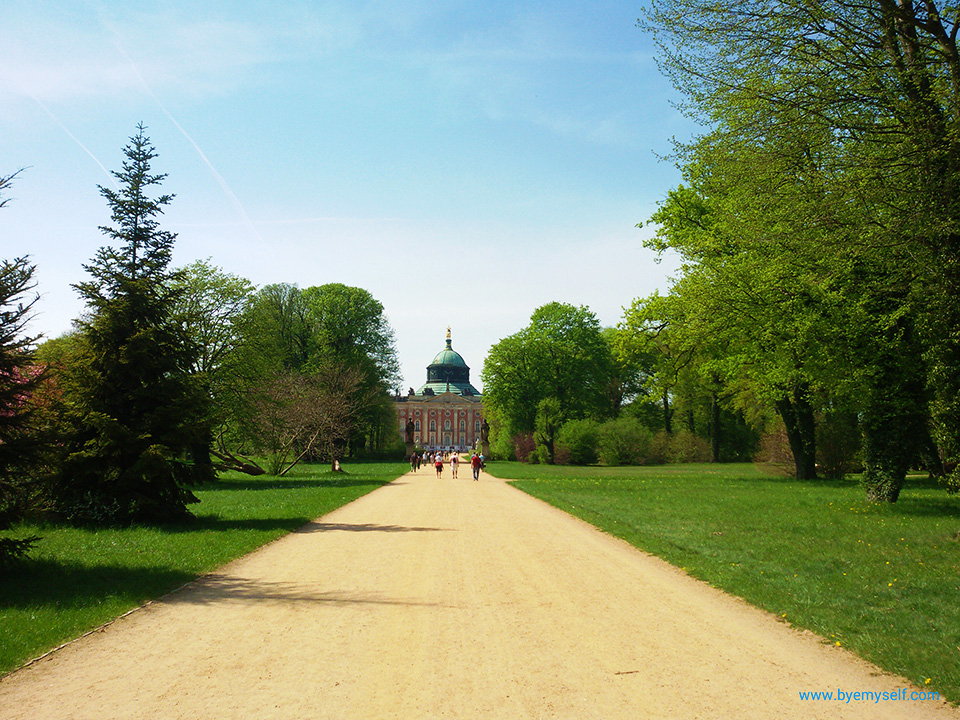
Depending on how much you want to see, I’d recommend renting a bike. But mind you that at Sanssouci park you are not allowed to cycle!
Short Circuit
Alter Markt
Already the Alter Markt, the old market, is a grand starting point.
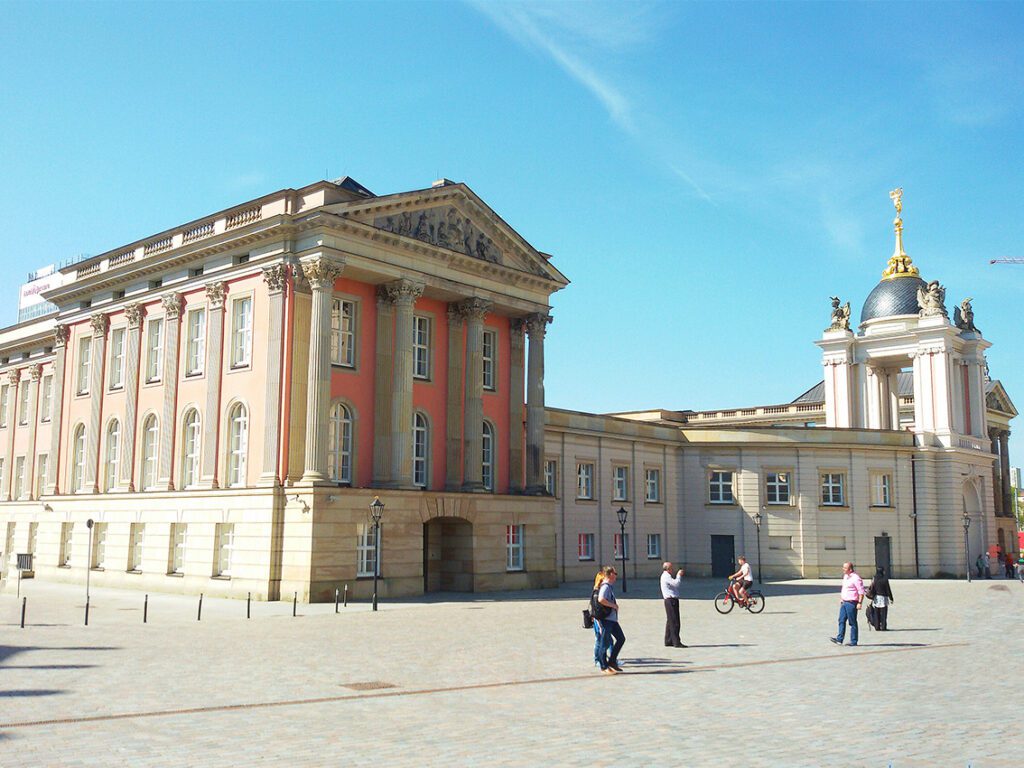
You stand in the center – next to the obelisk. Already the 25 meters / 82 feet high obelisk is a special structure. Georg Wenzeslaus von Knobelsdorff, one of Frederick II’s artist buddies, built it between 1753 and 1755.
Potsdamer Stadtschloss – the City Palace
Von Knobelsdorff also designed the Potsdamer Stadtschloss. This City Palace was one of the two Royal’s official seat. The other one being the Stadtschloss in Berlin.
Seeing it today, you won’t believe that the Stadtschloss of Potsdam was damaged at the end of WWII. Eventually, the GDR government demolished it completely. The square then served as a parking lot – although there weren’t hardly any cars.
The reconstruction was completed in 2014 – financed by donations of wealthy citizens. Today, the building houses the Landtag, the State Parliament.
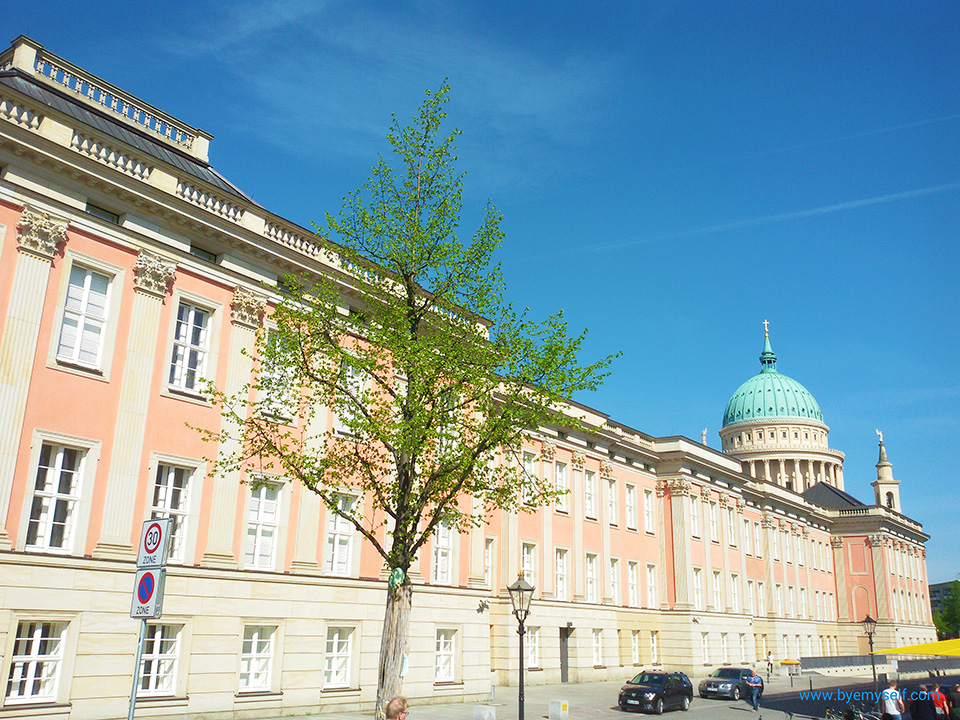
Potsdam Tourismus organizes guided tours of the building Monday to Friday from 8 a. m. to 6 p. m.


St. Nikolaikirche – Saint Nicholas’ Church
Across from the Stadtschloss’ main gate is the St. Nikolaikirche, Saint Nicholas’ Church, a Protestant church, built in two steps in the middle of the 19th century according to a design by Karl-Friedrich Schinkel.
Schinkel’s idea was to copy the Castel Sant’Angelo in Rome. I know, it looks nothing like its model, but at that time, Rome was the epicenter of European art. Hence, all the painters, sculptors, and architects spent time there to get inspired by the ancient Roman Empire and transform it into classicism.
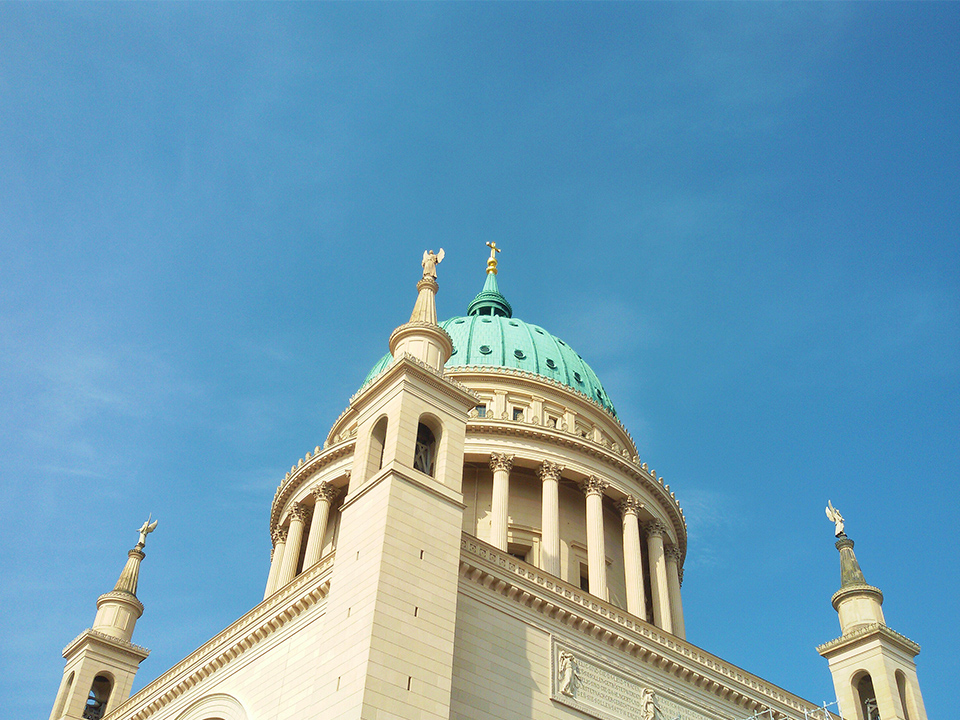
Although the church, too, was damaged during the air raid in April 1945, interestingly, it was repaired and renovated little by little already during the GDR era.
Potsdam Museum
On the square’s eastern side is another majestic building – the former town hall. Built from 1753 to 1755, it was re-opened only in 2012 and houses the Potsdam Museum. The big building is connected through a smaller, new one to the Knobelsdorffhaus.
Georg Wenzeslaus von Knobelsdorff designed many, many of Potsdam’s beautiful buildings.
The Potsdam Museum houses, of course, exhibitions on the city and its rich and everchanging history, but also paintings and sculptures.
Potsdam Museum – Forum für Kunst und Geschichte
Am Alten Markt 9
14467 Potsdam
Phone: + 49 331 – 2896868
Email: museum-geschichte@rathaus.potsdam.de
The museum is open Tuesday to Sunday from 10 a. m. to 5 p. m.
On Thursday till 7 p. m. and weekends till 6 p. m.
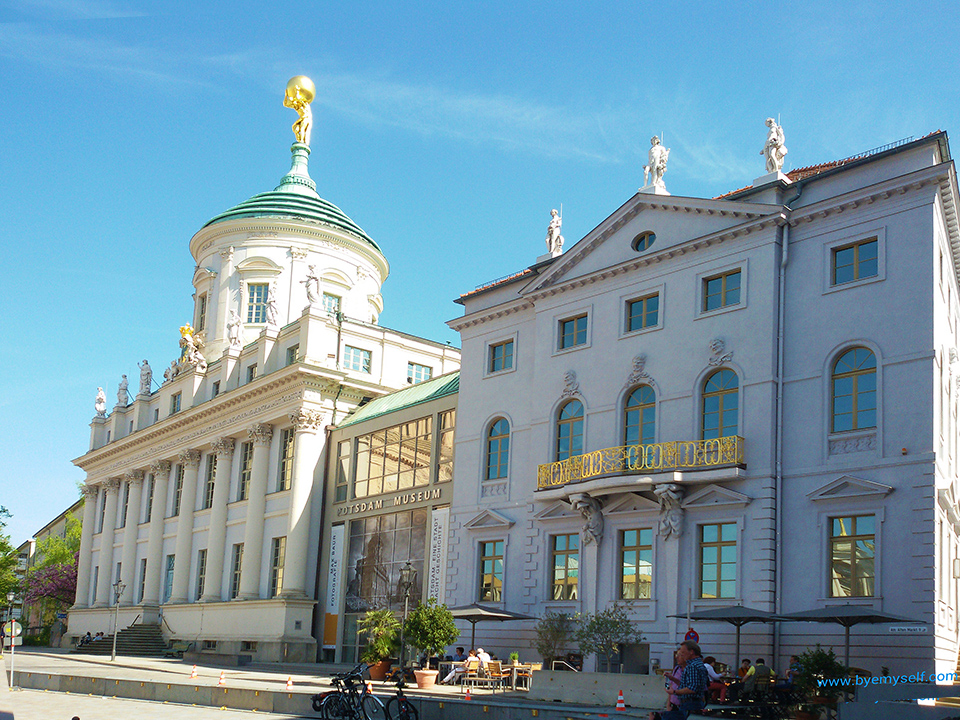
In the middle is the annex where the entrance to the museum is located and to the right the Knobelsdorffhaus – built by Frederick’s buddy Georg Wenzeslaus von Knobelsdorff (hence the name).

Last Not Least: The Barberini Palace
The lastly remodeled Palace in this square is the Museum Barberini which was finished only in January 2017.

Now the old market shines in its former splendor again.
The Palace is basically a copy of the real Palazzo Barberini in Rome. As I mentioned before: In the 18th century, Italy was the undisputed paragon of beauty and aesthetics.
The Barberini was restored with the money from the Hasso Plattner Foundation and shows changing temporary art exhibitions. Hasso Plattner made a fortune as a co-founder of a German software company, by the way.
Museum Barberini
Humboldtstraße 5–6
14467 Potsdam
Phone: + 49 – 331 – 236014-499
Email: besucherservice@museum-barberini.com
Open Wednesday to Monday from 10 a. m. to 7 p. m.
Actually, all the buildings along the Humboldtstraße across the street from the City Palace are strongly inspired by Italian palazzi.
The Film Museum
Once done admiring the posh facades on Humboldstraße, turn right on Friedrich-Ebert-Straße and you’ll get to another pompous building. Built in 1685 as an Orangery Palace, it was transformed in the 18th century by – you guess whom?! Correct: Von Knobelsdorff – and served as a stable for the King’s riding horses. Already in 1981, the building was turned into a film museum by the GDR government – and has been a film museum ever since.
Why Potsdam has a film museum? We’ll get to that later on the Grand Circuit.
Filmmuseum Potsdam
Breite Straße 1A
14467 Potsdam
Phone: + 49 – 331 – 27181-12
Email: info@filmmuseum-potsdam.de
The museum is open from Tuesday till Sunday 10 a .m. to 6 p. m.
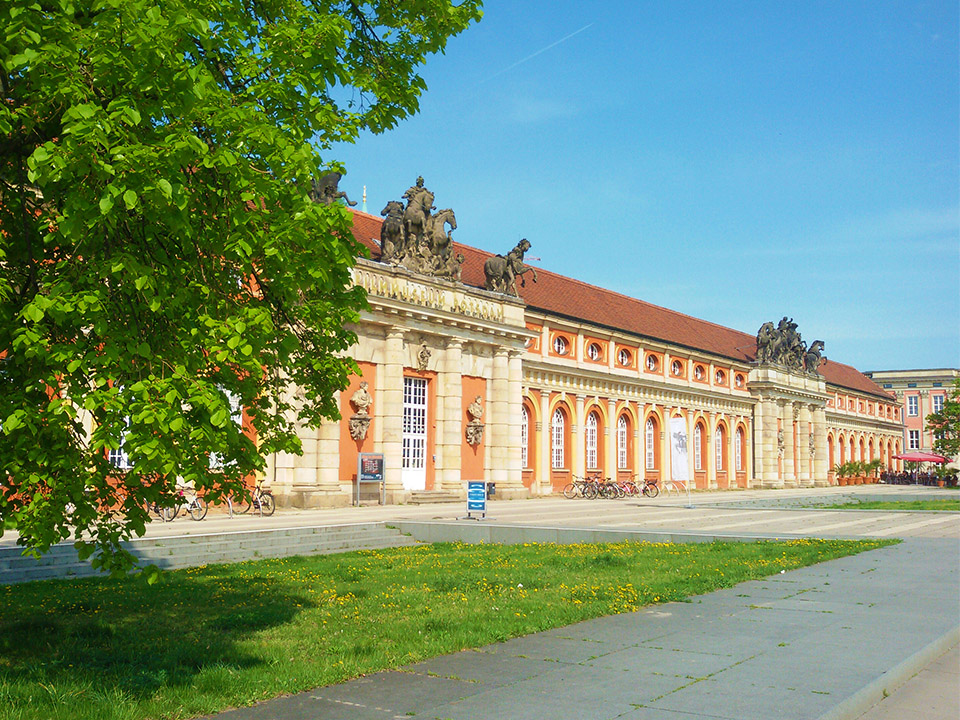
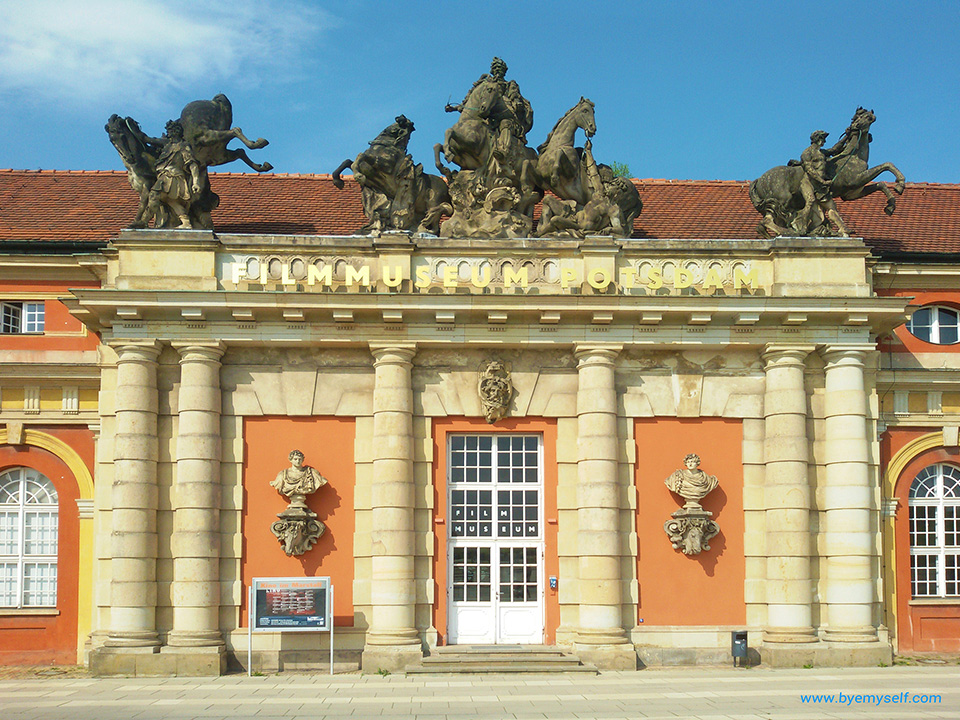
Neuer Markt
After you’ve already visited the Alter Markt, the old market, you should see also the Neuer Markt, the new market, located in the back of the Filmmuseum: Turn right into the Schloßstraße and wander the cobblestone alleys to the Neuer Markt square.

The House of Brandenburg-Prussian History
Besides the old charming houses that make this area look like an open-air museum, anyway, there is the Haus der Brandenburgisch-Preußischen Geschichte, the House of Brandenburg-Prussian History, taking you back in time.
This museum is also great for kids since it does not only house a huge model of the city – showing its privileged location nestled between the most scenic lakes – but also many artifacts making the old times and stories come alive.
Haus der Brandenburgisch-Preußischen Geschichte
Am Neuen Markt 9
14467 Potsdam
Phone: + 49 – 331 – 620 85-50
Email: kasse@gesellschaft-kultur-geschichte.de
Opening hours Tuesday to Thursday 10 a. m. to 5 p. m., Friday to Sunday10 a. m. to 6 p. m.

After having explored this alluring old neighborhood and maybe having taken a rest and a cup of coffee for instance at the Café Kutschstall (which means, of course, carriage stable, what else?!), walk up north and you’ll get to the Alter Stadtkanal, the old city channel.
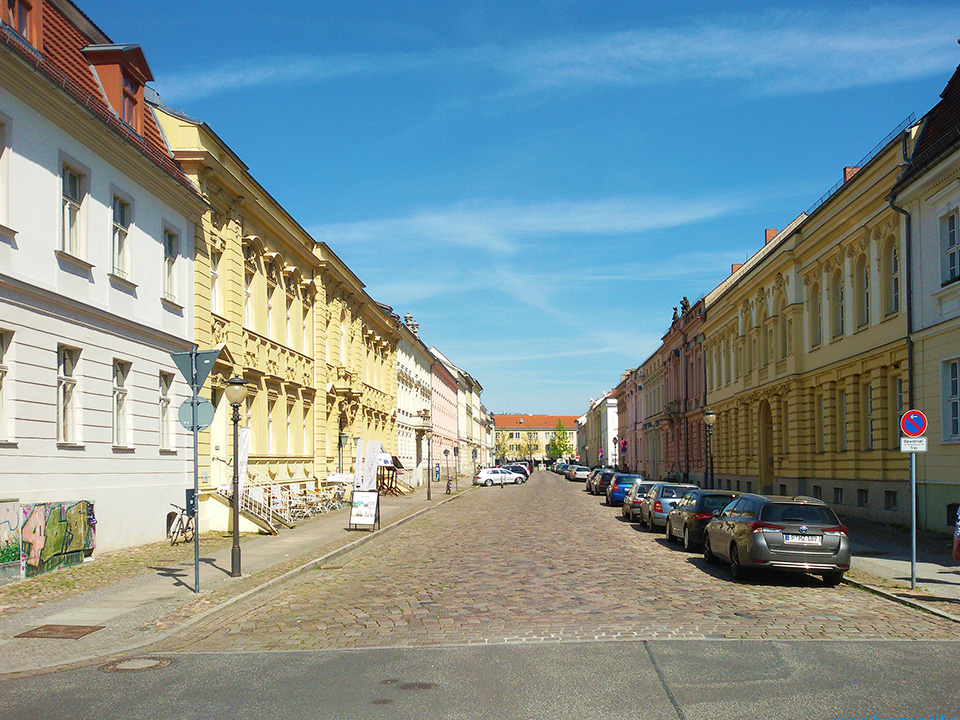
Across the Old City Channel
Cross the bridge and keep on walking, awing at all the gorgeous buildings left and right. Keep walking and awing along Wilhelm-Staab-Straße and then Jägerstraße until you get to the Brandenburger Straße – Potsdam’s pedestrian shopping mile.
If you turn left, you’ll get to the Stadtpalais, the City Palace, which was built in 1905 to house a department store. After a chequered history according to the political and economic twists and turns, in 2005, after expensive restoration, it became again a branch of the German traditional store chain Karstadt.
Turning right on Brandenburger Straße, you walk straight towards the Catholic Peter and Paul Church.

Holländisches Viertel
In front of the church, turn left, walk two blocks and you find yourself surrounded by a completely different architecture. The Holländisches Viertel, the Dutch quarter that I’ve mentioned before, is built in the red clinker brick style. Pretty puristic compared to all the sumptuous neo-classicist facades.
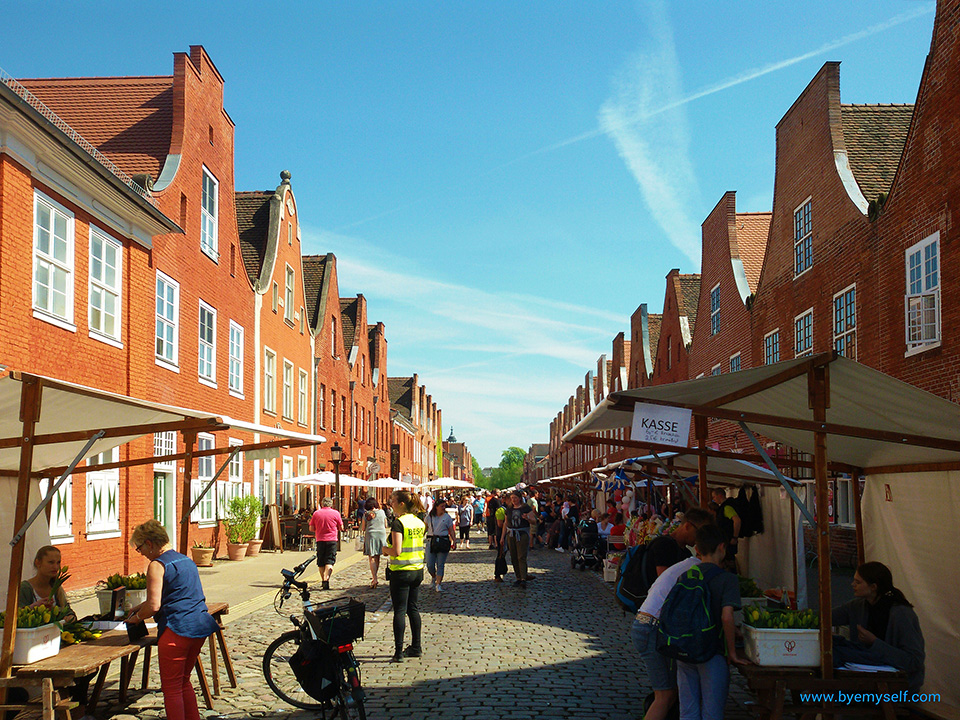
To learn more about the open minds – and open arms – of the Prussian Kings that brought these immigrants, not exclusively from the Netherlands, to Potsdam, visit the Jan Bouman House, the first house in Potsdam built by immigrants and named after the Dutch master builder Jan Bouman who controlled the erection of the Holländisches Viertel, consisting of 134 of these brick houses, and many other buildings around Potsdam and even Berlin.
Jan Bouman Haus
Mittelstraße 8
14467 Potsdam
Phone: + 49 – 331 – 2803773
Email: info@jan-bouman-haus.de
Opening hours are Monday to Friday from 1 p. m. to 6 p. m., and weekends from 11 a. m. to 6 p. m.
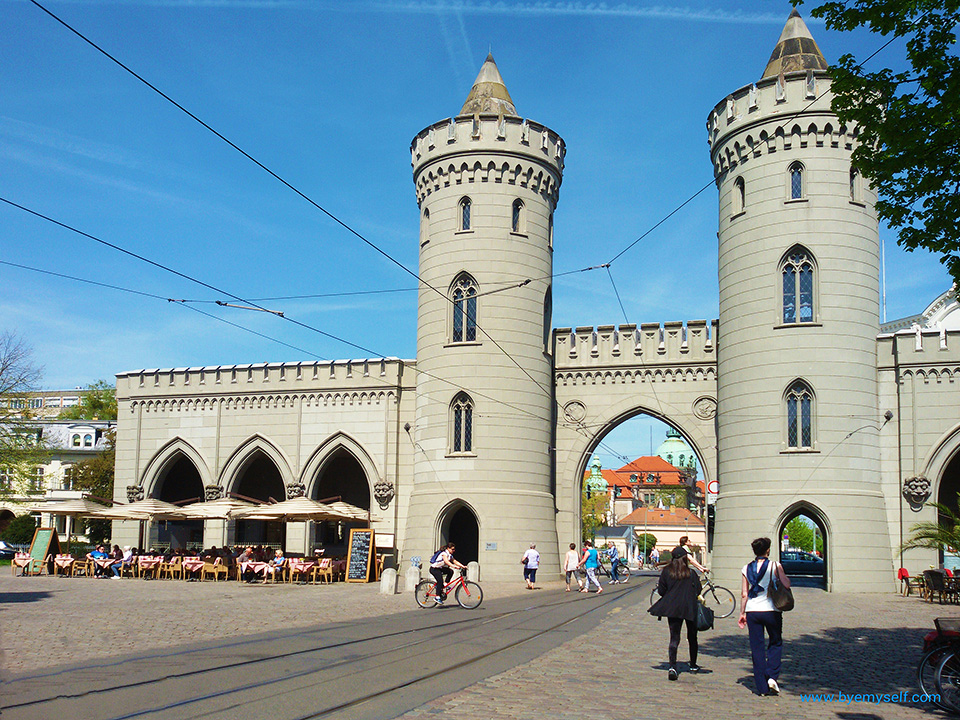
Sanssouci
And now it’s time to pay the good people a visit who made Potsdam great (again), and where better could this be than at Park Sanssouci. In French, it means no worries.
Walk down the Hegelallee, which is quite a walk, but a nice one.
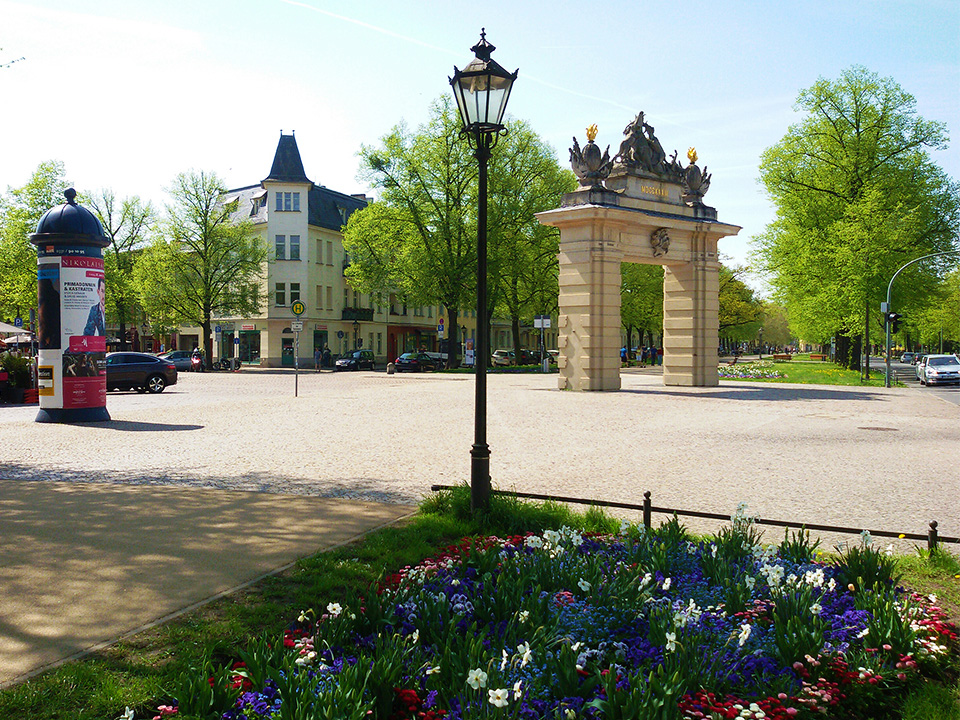
The Friedenskirche – Rest in Peace
You’ll enter the premises at the South East corner where the Friedenskirche, the Church of Peace, is located. Its annex is the Kaiser Friedrich Mausoleum. Added in 1890, it is the final resting place of members of the House of Hohenzollern. Not Frederick II, though.
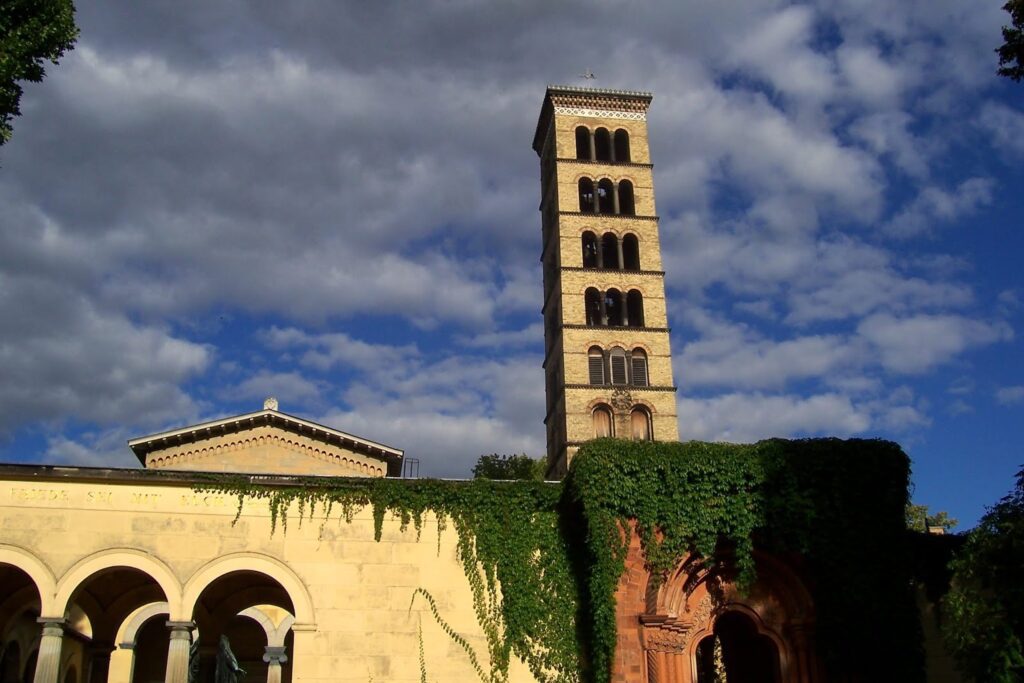
(Stefan14776, Potsdam-friedenskirche, als gemeinfrei gekennzeichnet, Details auf Wikimedia Commons)
The park has a size of over a square mile and cycling is not permitted.
So walk from the church to the central alley that will open to your right. You cannot miss it since you’ll have the iconic view of – tadaa – Sanssouci Palace.
It is a majestic view as you stroll towards it, walking around the large fountain surrounded by beautiful sculptures made by French artists of snow-white marble.
Some of them were a gift by Louis XV.
I didn’t count them, but they say that there are about 4,000 statues scattered across the park, some solo, some arranged in picturesque groups.

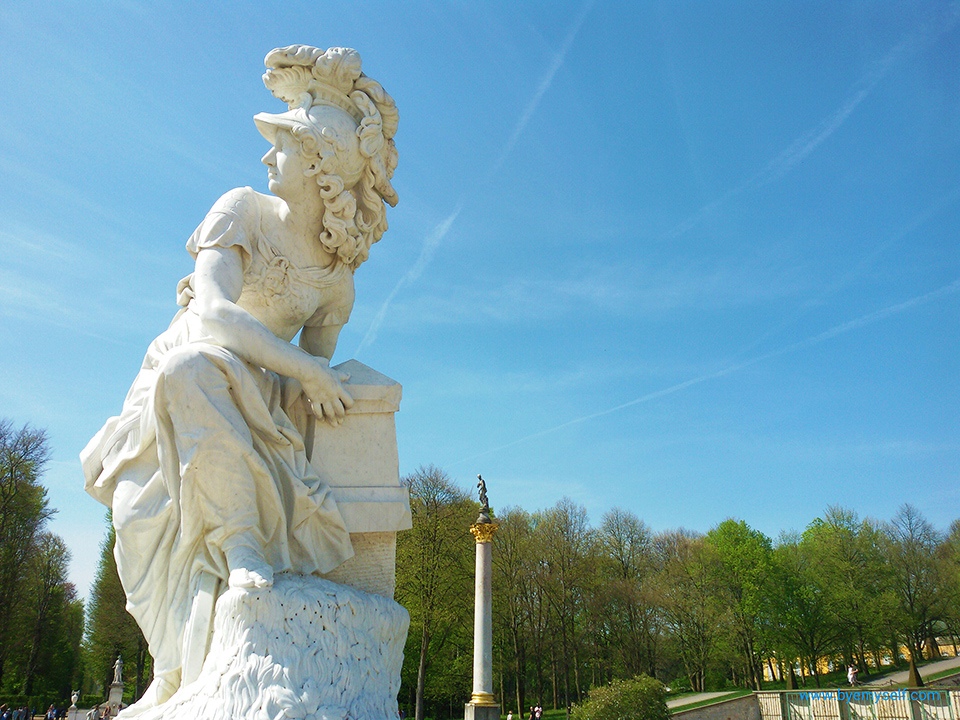
Sanssouci
The Palace Sanssouci, built by our old buddy Knobelsdorff, is a fine specimen of dainty rococo architecture. I had been there in April, so I did not see the vineyard in full bloom, but the sight was mesmerizing just the same.
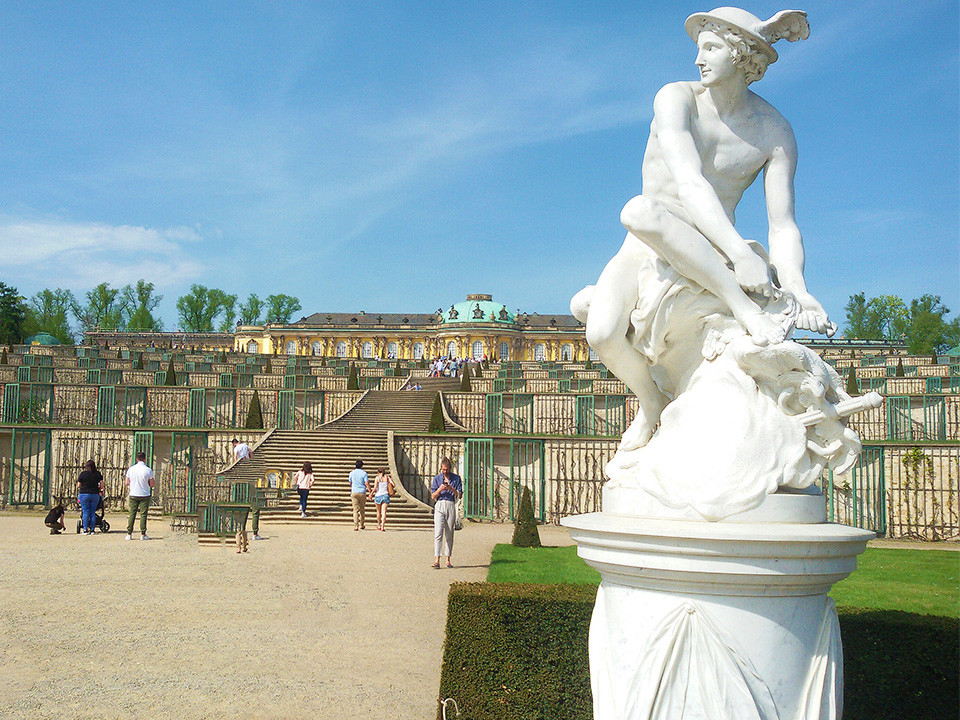
Of course, the Palace can be visited. They supply you with an audio guide and then you can take your time admiring all the sublime furnishing and decoration.
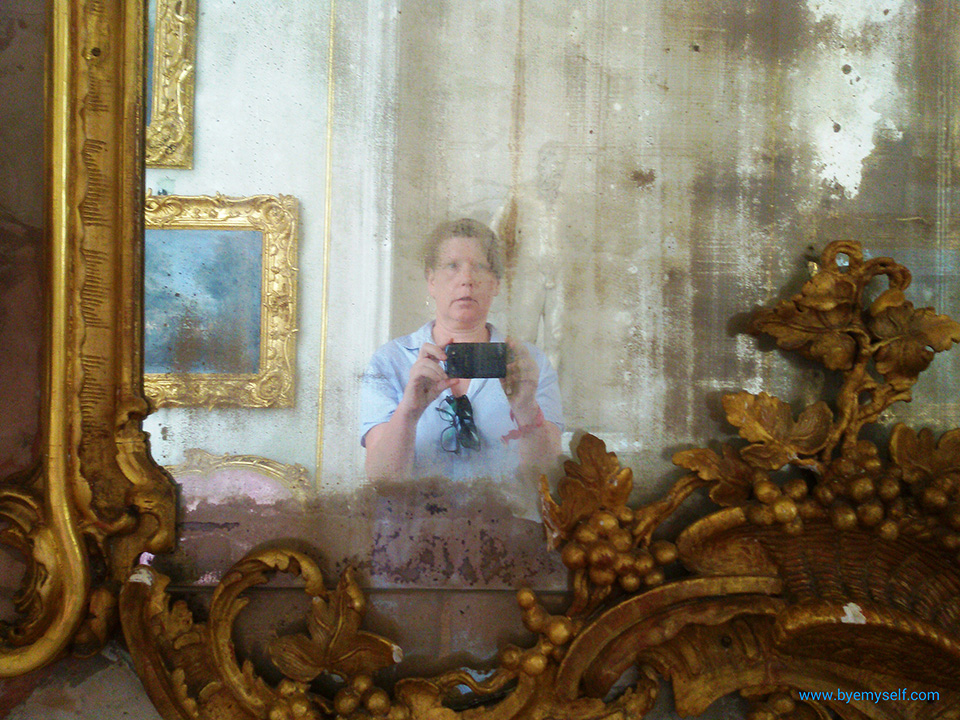

Although I’m usually not so into kitsch, I really like the last room. Painted and decorated like a jungle-ish aviary with a tapestry full of flowers and fruits and carved parrots, it is pretty unique.
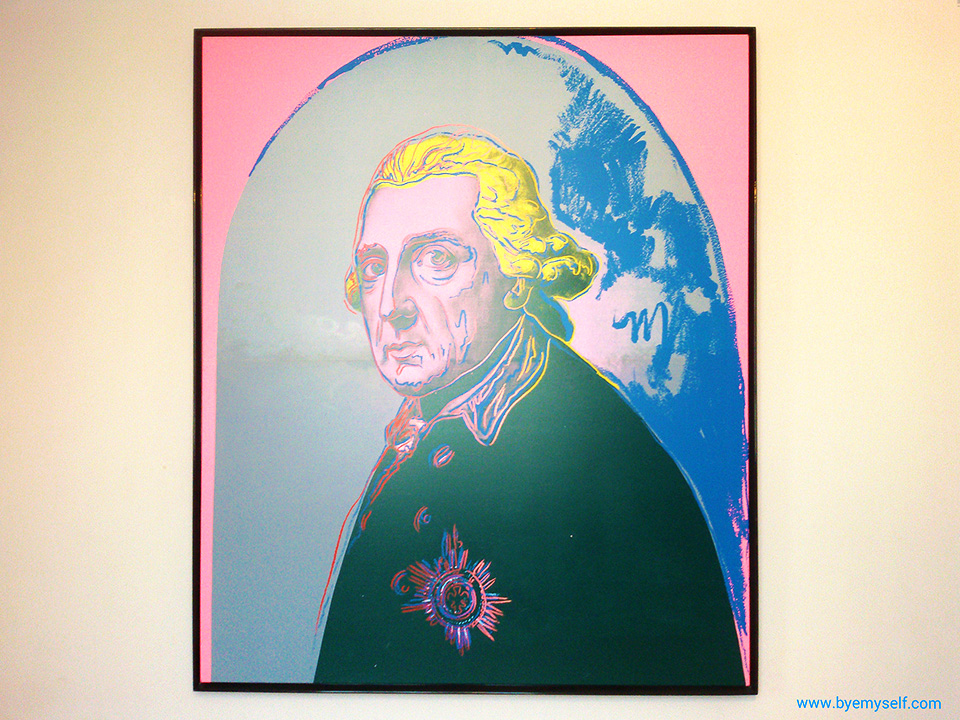
This portrait is to be found in one of the former servant’s rooms at the end of the tour.
Well, the Palace is by far not the only superb structure to be admired at the park. Walking down westward the main alley, just imagine how the King came riding down where you are walking right now – all by himself, no visitors from Spain, Italy, India, or France being in his way asking for selfies.
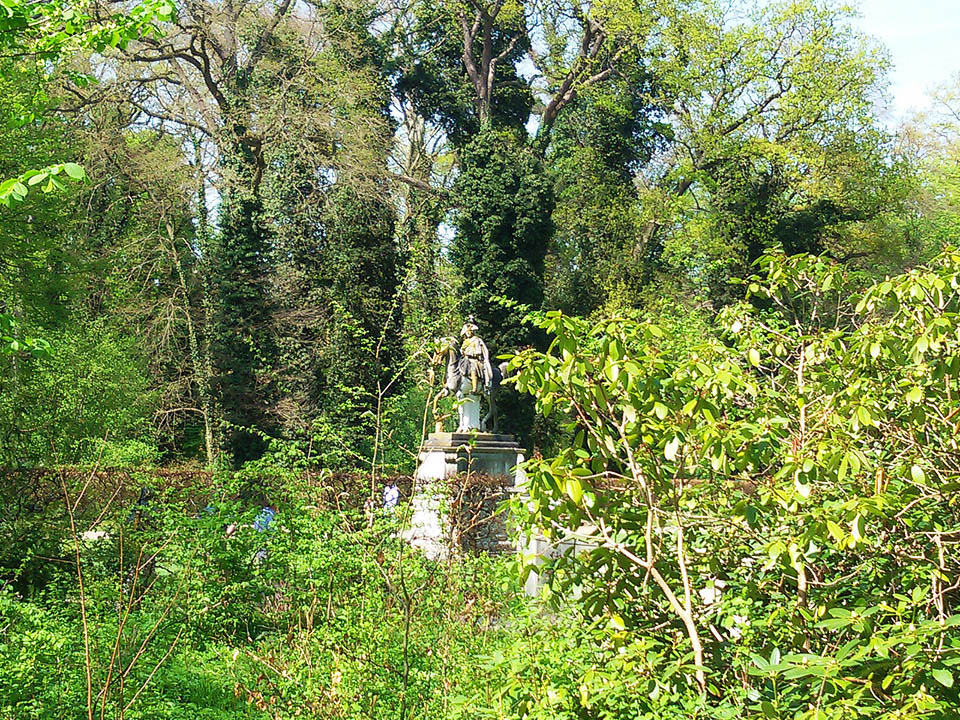
The Dutch Mill
Soon, to your right, you’ll spot the Neue Kammern, the new chambers, with the Historic Mill in the backdrop. This Dutch mill houses a Technical Museum, teaches you all about…mills.

The way leading from the mill towards the Orangery is named Maulbeerallee, Mulberry Alley. Remember – Frederick II enforced the production of silk in Potsdam.
Following the Maulbeerallee from the Orangery to the Klausberg behind the Royal Vineyard, you can walk up to the Belvedere where you have…a pretty bel vedere, i. e. a great view of the land that once was Frederick’s.
The New Palace
From up there, you probably already spotted the other grand Palace of Sanssouci the Neues Palais, the New Palace. While the Sanssouci Palace was finished in 1747, this regal building was added in 1769. You will immediately recognize the color and style of some of the buildings around Potsdam, namely the Stadtschloss.
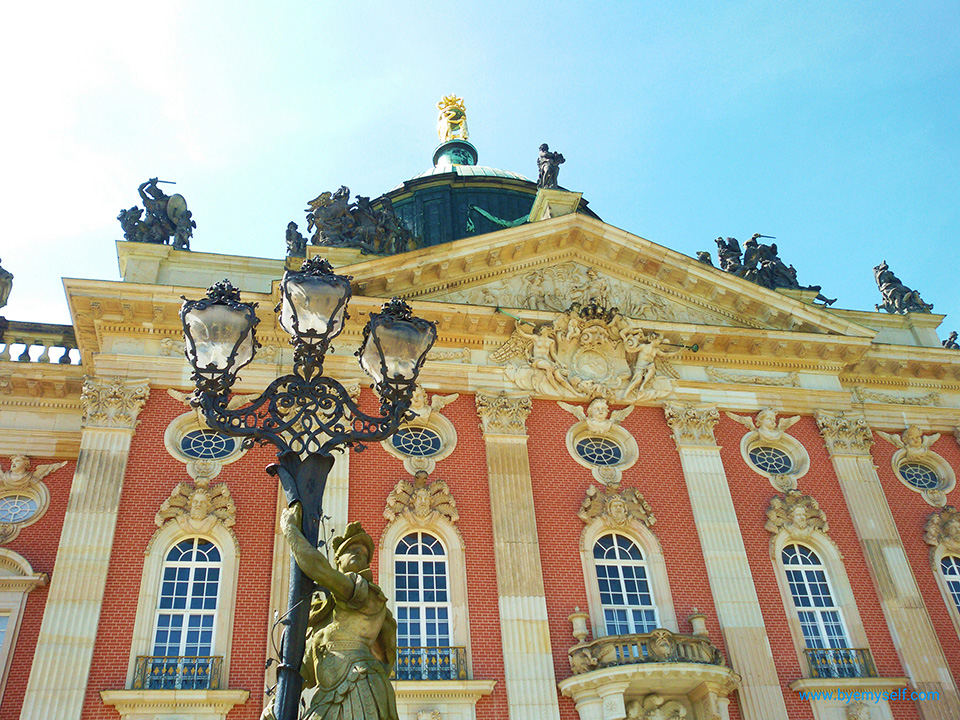
Pay attention to all the beautiful details, the lanterns, the statues, and the three gilded graces on top of the roof. It’s all so stupefying.
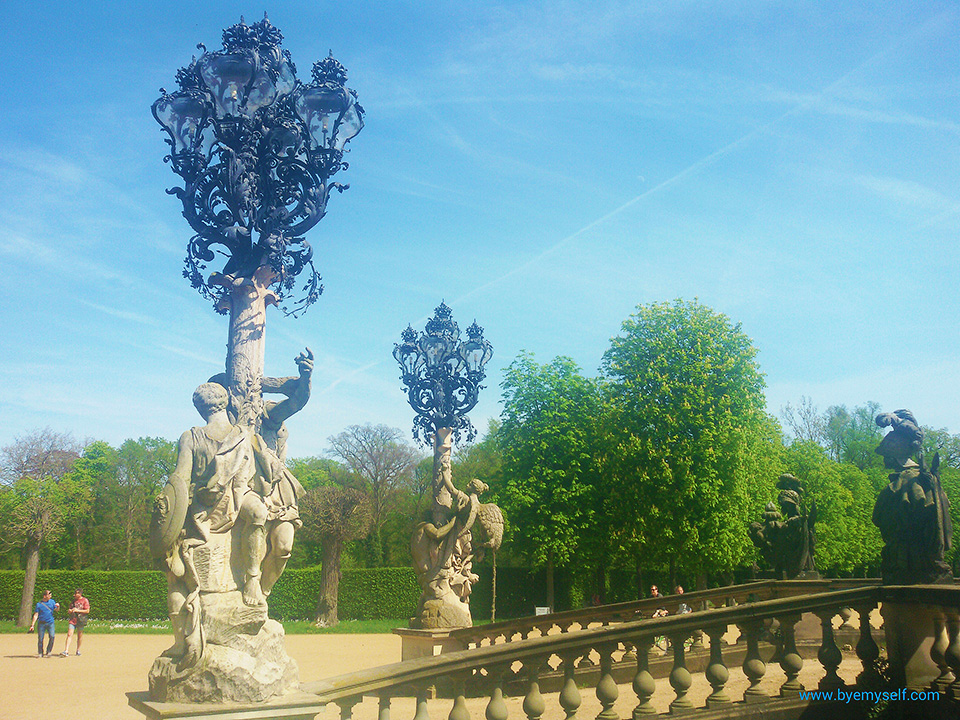
Behind the New Palace, by the way, is Potsdam University.
There are various ticket options – from a single visit to the Sanssouci Palace to a family ticket for two adults and up to four kids covering various castles around Potsdam, so you have to check their website before you go. Anyway, since places are limited, I’d recommend you make an online reservation – you have to choose a precise slot and be there on time.
Schloss Sanssouci
Maulbeerallee
14469 Potsdam
Phone: + 49 – 331 – 96 94-200
Email: info@spsg.de
Depending on the season, the opening hours are from 10 a. m. either till 4.30 p. m., 5 p. m., or 5.30 p. m.
Alexandrowka
I know, you’ve walked a lot. You’re tired. But it would be a shame if you missed out on one of Potsdam’s greatest curiosities, the Russian quarter Alexandrowka.
If you don’t feel like walking the two miles, you can as well take bus #695 at the stop Neues Palais and get off after 15 minutes at Reiterweg/Jägerallee.
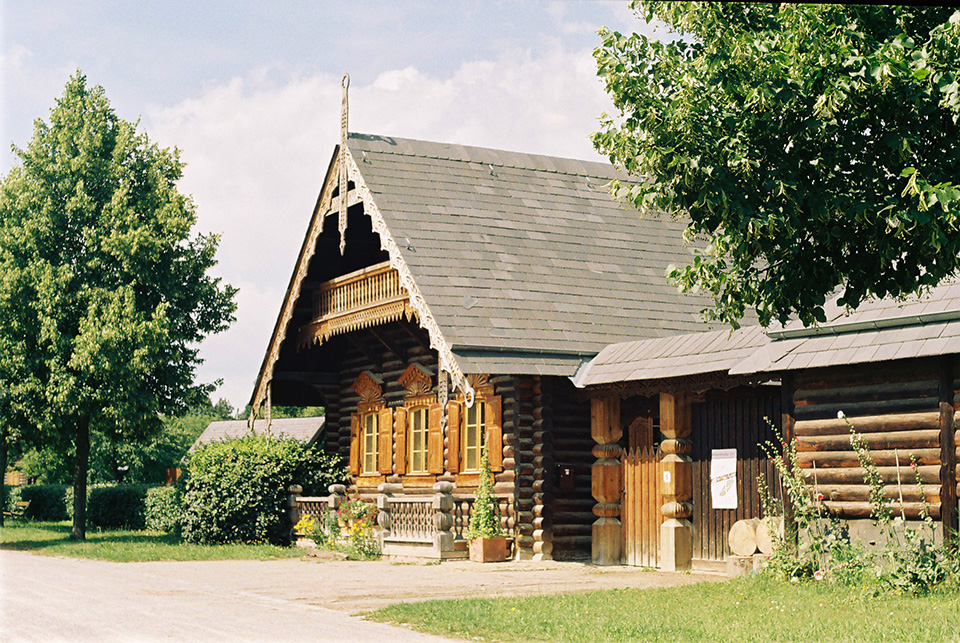
(Photo: Mrsklonk, Russische Kolonie Alexandrowka in Potsdam, CC BY-SA 4.0)
The Alexandrowka is one of these quirky gifts and souvenirs the nobles gave each other.
In 1826 and 1827, King Frederick William III commissioned this colony for twelve Russian singers, remaining of a choir of 62 soldiers.
The Prussian Hohenzollern and the Russian Romanovs were connected by familial and amicable relations. Hence, the colony was called Alexandrowka in honor of Tsar Alexander.
The complex consists of twelve small farmsteads and an overseer building.
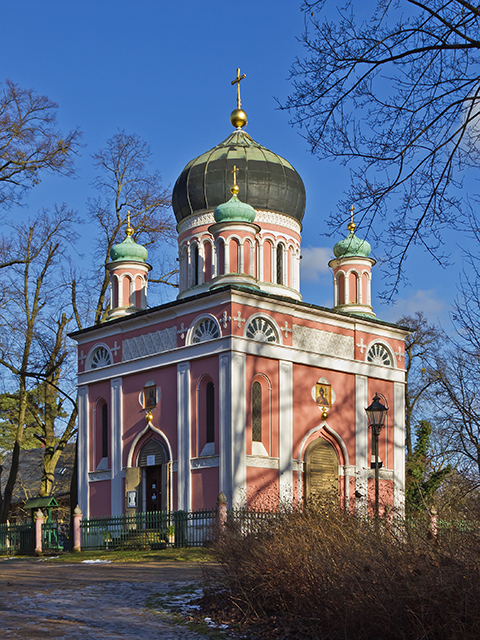
(Photo: A.Savin (Wikimedia Commons · WikiPhotoSpace), Potsdam Alexandrowka 02-14 img4, CC BY-SA 3.0)
On the Kapellenberg in the colony’s vicinity stands the Russian-orthodox Alexander-Newski-Memorial Church.
To learn more about this really special neighborhood, visit the adjacent museum.
Since it’s not always open, check their website for the latest information.
Oh, and when you visit on your birthday, entrance is free. This way, you save only 3,50 €uro, nevertheless, I find it’s a really cute idea.
Museum Alexandrowka
Russische Kolonie 2
14469 Potsdam
Phone: + 49 – 331 – 8 17 02 03
Email: info@alexandrowka.de
Going back from the Alexandrowka to the main station, you can take bus #603 at Reiterweg/Alleestraße or bus #695 to S-Bahn Potsdam Hauptbahnhof.
Defining History
So, guys, these are the most important attractions to see around the center of wonderful Potsdam. You see there’s a lot of stories and history.
What I still haven’t even mentioned is the historic importance of Potsdam at the end of WWII. The victorious powers the USA, the United Kingdom, and the Soviet Union met in Potsdam to negotiate how to proceed with what was left of Europe.
In the end, they signed the Potsdam Agreement, determining the division of Germany into four zones. Eventually, the territory occupied by the Soviet Union became the German Democratic Republic, short for GDR.
Anyway, following my steps through Potsdam according to this itinerary, you can make it in one (long) day including maybe two visits to museums. However, this shows you that you won’t get bored visiting for two or even more days. Actually, at Sanssouci alone, you can spend an entire day.
Then there are the outskirts and surroundings that are really beautiful and worth a visit, too.
Long Circuit
The best way to visit – at least in Summer – is to rent a bike and cycle around the scenic lakes like e. g. Heiliger See, the holy lake, where many German celebrities have beautiful mansions in the Berliner Vorstadt neighborhood.
Cecilienhof
There is another imposing Palace you shouldn’t miss. It’s the Cecilienhof, the last Palace built by the Hohenzollern. Kaiser William II commissioned this home for his oldest son Prince Royal William. It was William’s home till 1945 – he shared it with his wife Cecilie.
The architecture adapts nicely to the rustic surroundings.

(Photo: Jean-Pierre Dalbéra from Paris, France, La cour intérieure du château de Cecilienhof (Potsdam) (2731361224), CC BY 2.0)
It was at Cecilienhof where the representatives of the victorious powers held the Potsdam conference in 1945.
Schloss Cecilienhof
Im Neuen Garten 11
14469 Potsdam
Phone: + 49 – 331 – 96 94-200
Email: info@spsg.de
At Cecilienhof, too, you have various options regarding the entrance ticket – and it is also part of the Sanssouci + ticket if you choose so.
Opening hours vary according to those of Sanssouci Palace.
Another important attraction is the Babelsberg Film Studio, located across the Tiefer See, the Deep Lake, from the Berliner Vorstadt. Therefore, you can just cycle across the Glienicker Brücke, the bridge crossing the Glienicker Lake. I’ve told you there are many, many lakes around Potsdam. This bridge is connecting the Federal Country of Brandenburg and Berlin, which is, just like Hamburg and Bremen, a city and at the same time a Federal State.
Schloss Glienicke and Babelsberg Palace
Here, you can first visit Schloss Glienicke north of Königstraße, the King’s Street, Prince Carl’s idea of an Italian Palazzo, designed by Schinkel and built in 1823.
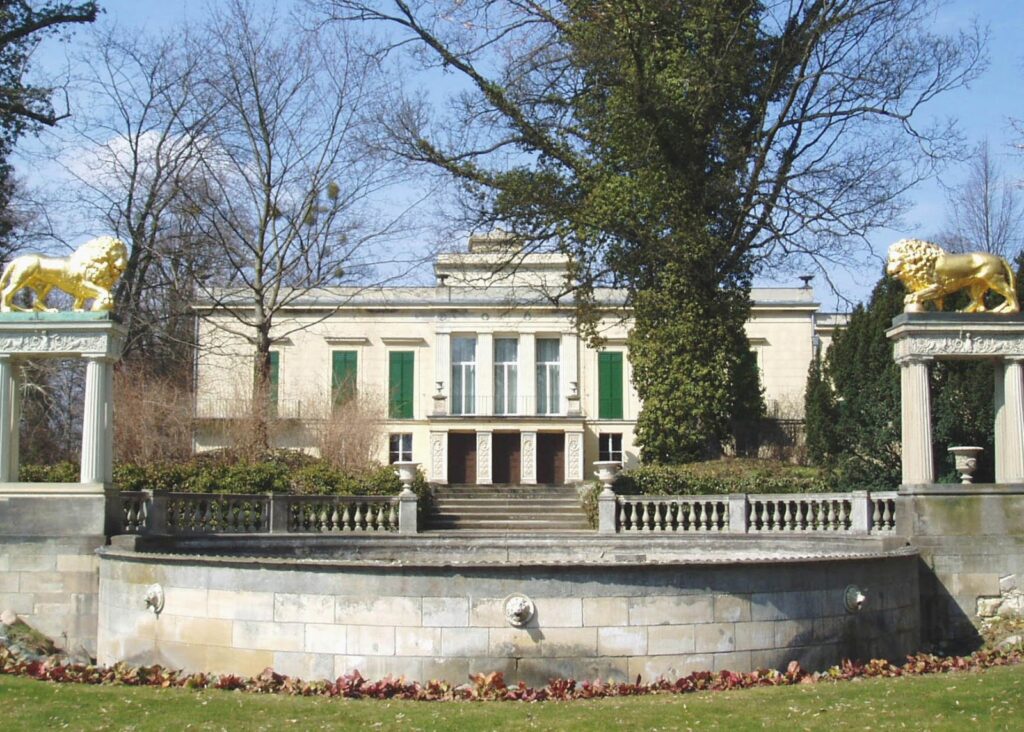
(Photo: Suse, Schloss Glienicke Süden, Formatted to 5:7, CC BY-SA 3.0)
Schloss Glienicke
Königstraße 36
14109 Berlin
Phone: + 49 – 331 – 96 94-200
Email: info@spsg.de
Cycle along the lake past the Jagdschloss Glienicke, the former hunting lodge. It cannot be visited since after its renovation, it’s housing a skill center. Cross the bridge at Lankestraße and you are in Babelsberg.
And, of course, there is a Palace here, too, and it’s a really beautiful one.
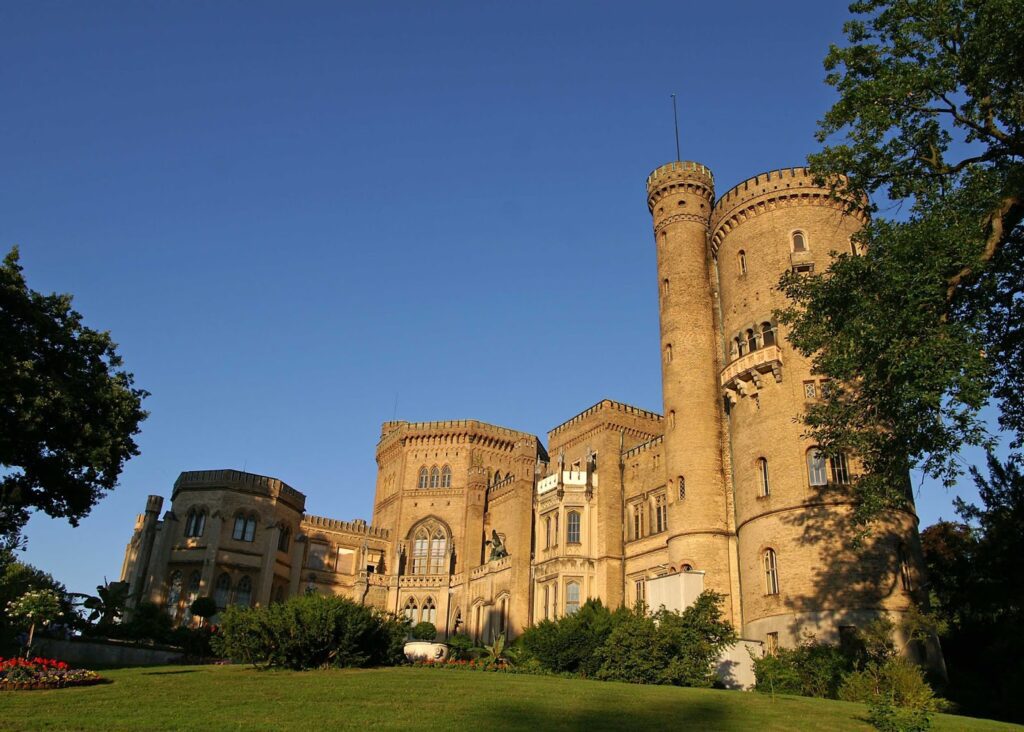
(Photo: Avantique, Schloss Babelsberg 3, Formatted to 5:7, CC BY-SA 3.0)
Commissioned by William I and built from 1833 to 1835, Babelsberg Palace is designed in a neo-gothic style and consequently resembles many English stone castles.
Schloss Babelsberg
Park Babelsberg 10
14482 Potsdam
Phone: + 49 – 331 – 96 94-200
Email: info@spsg.de
From this point, it’s about three miles to the Filmpark, so you can cycle there easy-peasy in about 15 minutes.
Hollywood in Germany
Babelsberg film studios were founded in 1912, thus they were the first major film studio worldwide.
In the early years, classics such as Fritz Lang’s Metropolis and Josef von Sternberg’s The Blue Angel starring Marlene Dietrich were shot here.
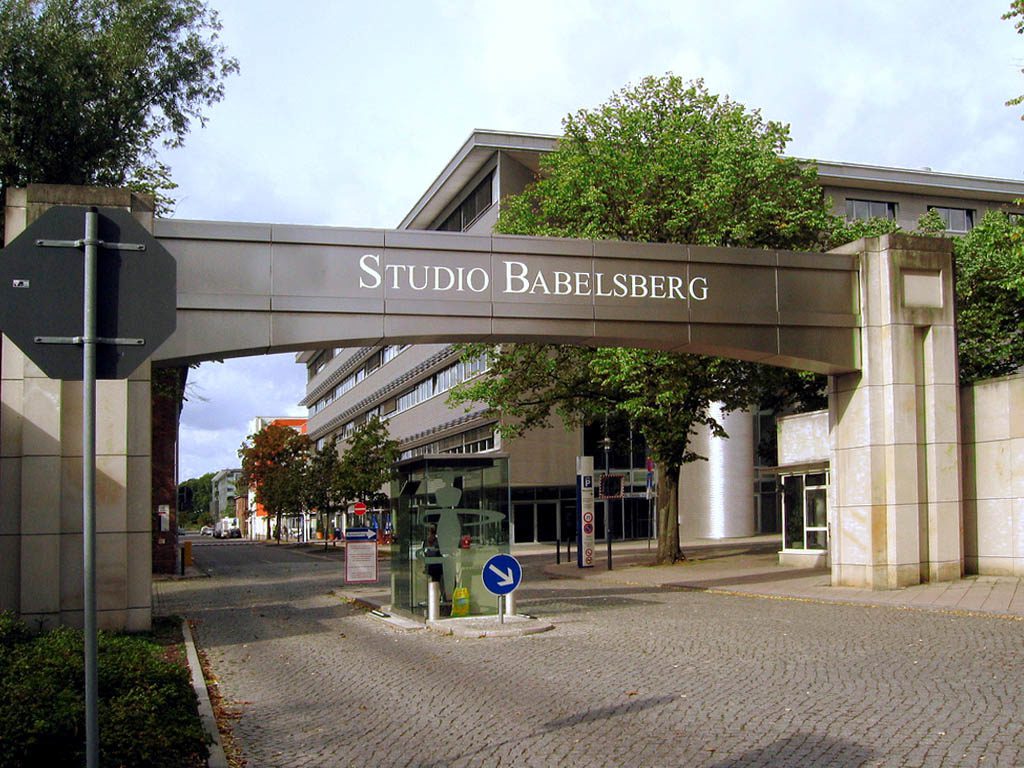
(Photo: Unify, Filmstudio Babelsberg Eingang, public domain, details on Wikimedia Commons)
The Nazis used it to shoot openly manipulative films or propagandistic movies, hence, political messages hidden behind entertaining stories.
After WWII, the GDR government established the DEFA, short for Deutsche Film AG, German Film SA.

(Photo: Havelbaude, Maria from metropolis, Formatted to 5:7, CC BY 3.0)
Following the reunification, the studios were handed from investor to investor, only since 2005, the studios are sailing in calm, profitable waters.
After all, they made movies like The Reader, featuring Kate Winslet, Inglorious Bastards by Quentin Tarantino and many other international productions right on these premises.
There are two visits – either the real studios (at this time only in Germany language) and the Filmpark which is like a Theme park e. g. in the United States; only that you probably won’t know many of the movie characters involved since it’s very German themed.
Studio Babelsberg AG
August-Bebel-Str. 26-53
14482 Potsdam
Phone: + 49 – 331 – 721 00 00
Email: info@studiobabelsberg.com
Filmpark Babelsberg
Großbeerenstraße 200
14482 Potsdam-Babelsberg
Phone: + 49 – 331 – 72 127 50
Ticket order: + 49 – 331 – 72 123 45
Email: info@filmpark.de
If you need to go back to Potsdam and do not want to cycle, catch the S-Bahn, the commuter train, at the station Babelsberg. From here, of course, you can also go to Berlin.
General Info
Getting there
Although Potsdam has barely 175,000 inhabitants, it is still the most densely populated city as well as the capital of the federal state Brandenburg. However, located about 40 kilometers South-West of Berlin, it can be easily reached by regional or urban train in more or less half an hour.
For instance, from the station Berlin, you can go to Potsdam either by regional train (train numbers starting RE…) or by commuter train (train numbers starting S…) e. g. from Bahnhof Zoo or Friedrichstraße. Potsdam is in zone C of the train system, so a single ticket costs 3,40 €uro, a day ticket, which you can use within one day as often as you like, costs only 7,70 €uro (and you can take up to three kids under 15 years of age with you).
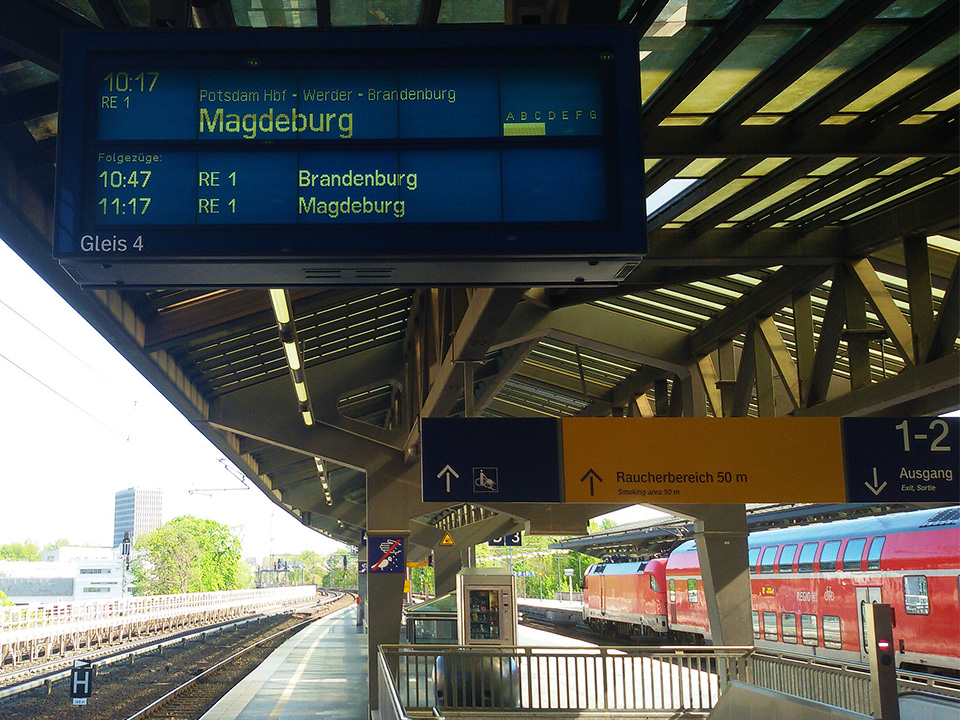
If you are travelling with others, evidently, a group ticket will be your best choice. For 20,80 €uro, up to five people can travel an entire day.
As I’ve already mentioned, there is no special tourist card for Potsdam, but the ‘large’ version of the Berlin WelcomeCard can be used in Potsdam, too.
Obviously, it really depends on what you are up to choose which option is suitable for you. For instance, if you want to spend the day almost exclusively at Sanssouci, getting a day ticket for the castles is (online) 21 €uro, add a 7,70 €uro for a day ticket and you are all set. The WelcomeCard for two days is 22,90 €uro, but you only get a discount on your entrance tickets.
Information
The guys at the Potsdam tourist information are very efficient and friendly and they have some great info material for free that allows you to explore the city on your own. However, to get some extra information, I recommend you join one of their walking tours.
For instance, the lady I went with had a profound knowledge of each and every detail and sprinkled her explanations with entertaining personal stories.
Potsdam Tourismus
Humboldtstraße 1-2
14467 Potsdam
Phone: + 49 – 331 – 27 55 88 99
Email: info@potsdamtourismus.de
Places to Visit
I’m an avid solo-travelling woman. However, solo-travel doesn’t equal solitude, hence, I love to join organized tours here and there. Also, since there is quite a lot to see at Potsdam, you might consider joining an organized tour so you don’t miss out on any of the most amazing spots*:
Where to Stay
It is certainly worth it to explore Potsdam on more than just a day trip from Berlin. Therefore, if you want to spend the night, here are some great options*
Booking.comMoney
Until now, 20 European countries replaced their former local currency with the €uro starting in 2002. Obviously, Germany is one of them. The exchange rate is 1 US$ = 0.94 EUR as of January 2023. However, you can check today’s conversion rate on this page.
Especially since the pandemic, cards are far more accepted than before.
Language
While in Germany, in general, most people speak pretty decent English, this might not necessarily be the case in the former GDR regions. Therefore it might be advisable that you learn a couple of useful words and phrases. You can practice online, for instance, using Babbel. The first lesson is for free and already supplies you with useful basic vocabulary.
In this post, I’m writing out some of the German names of brands and places. Obviously, you will notice that there are letters that might not exist in other languages.
Firstly, there is the letter ß which exists only in the German alphabet. It’s by no means a B – it’s a so-called sharp S. You pronounce it like the double S in kiss. So although the German word for street, Straße, looks quite exotic, it is simply pronounced Shtrasse. Mind you, when an S stands before a T, it becomes sh instead of s.
Then, there are three more vowels, ä being the easiest one since it’s pronounced like an open e as in head.
For some foreigners, ö and ü might be a bit tougher. Ö is pronounced more or less like the e in her. Finally, Ü sounds a bit like the u in huge.
Map
On this map, you can see the exact location of all those amazing places that I’m introducing in this post. Clicking on the slider symbol at the top left or the full-screen icon at the top right will display the whole map including the legend.
Pinnable Pictures
If you choose to pin this post, please use one of these pictures:
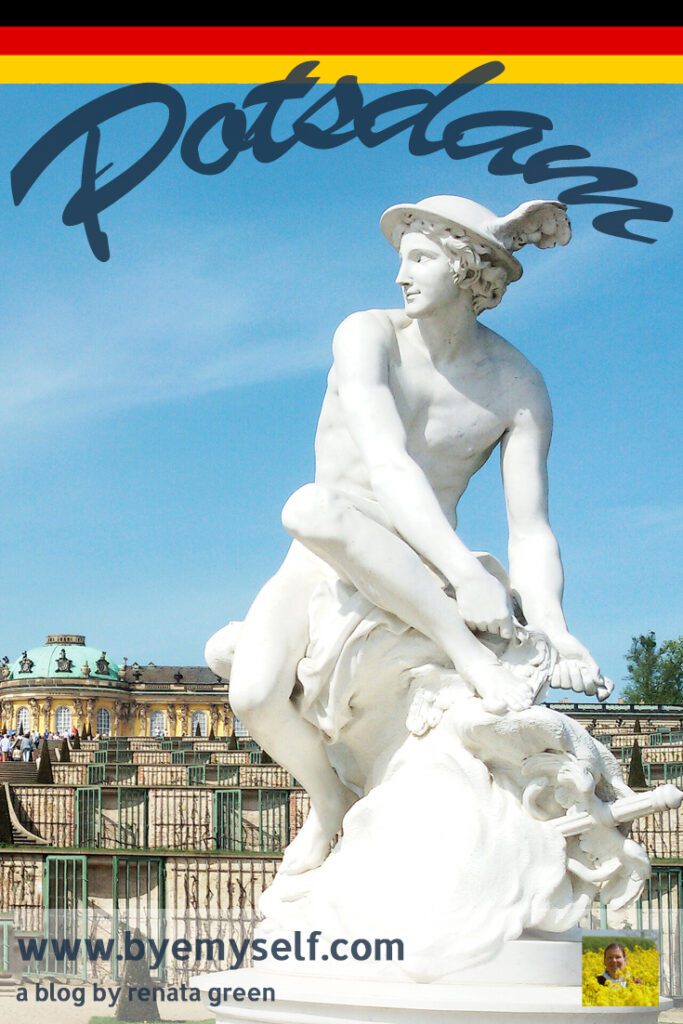
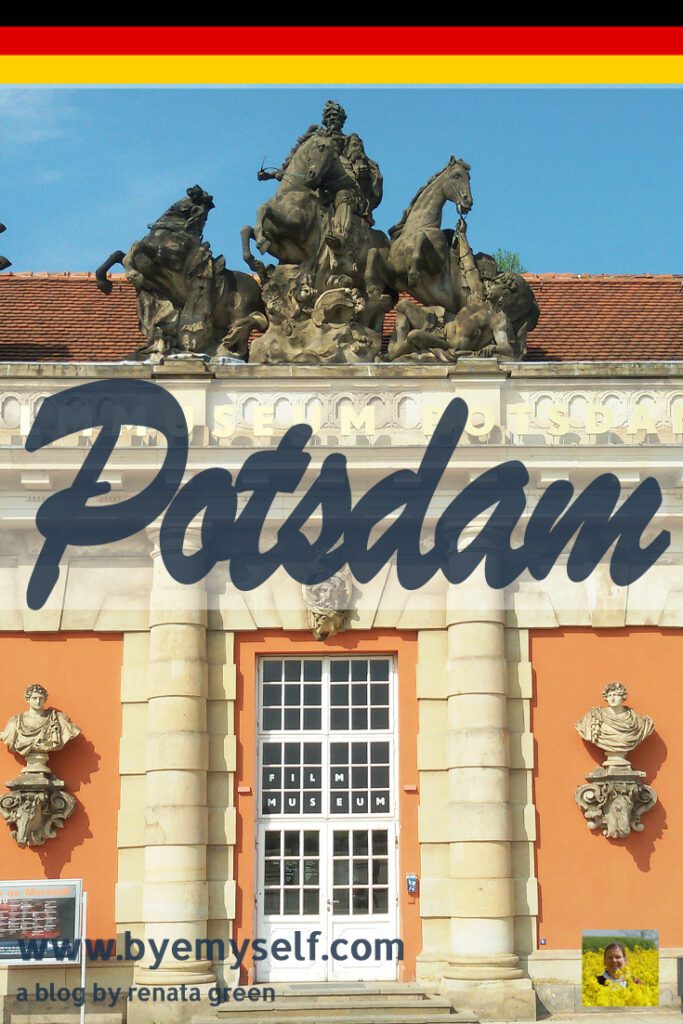
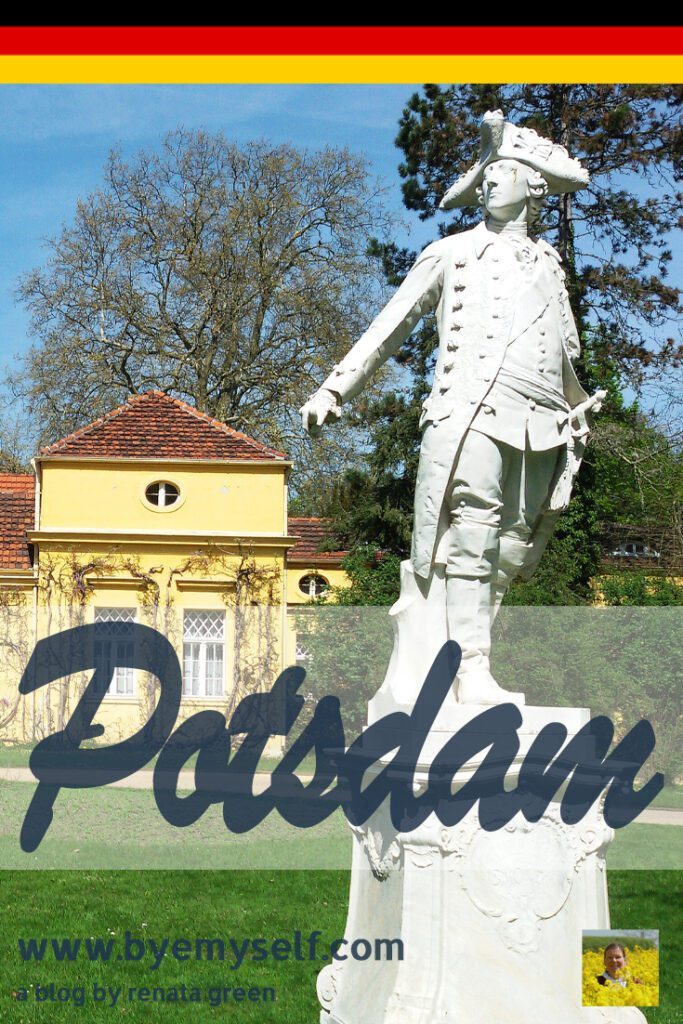
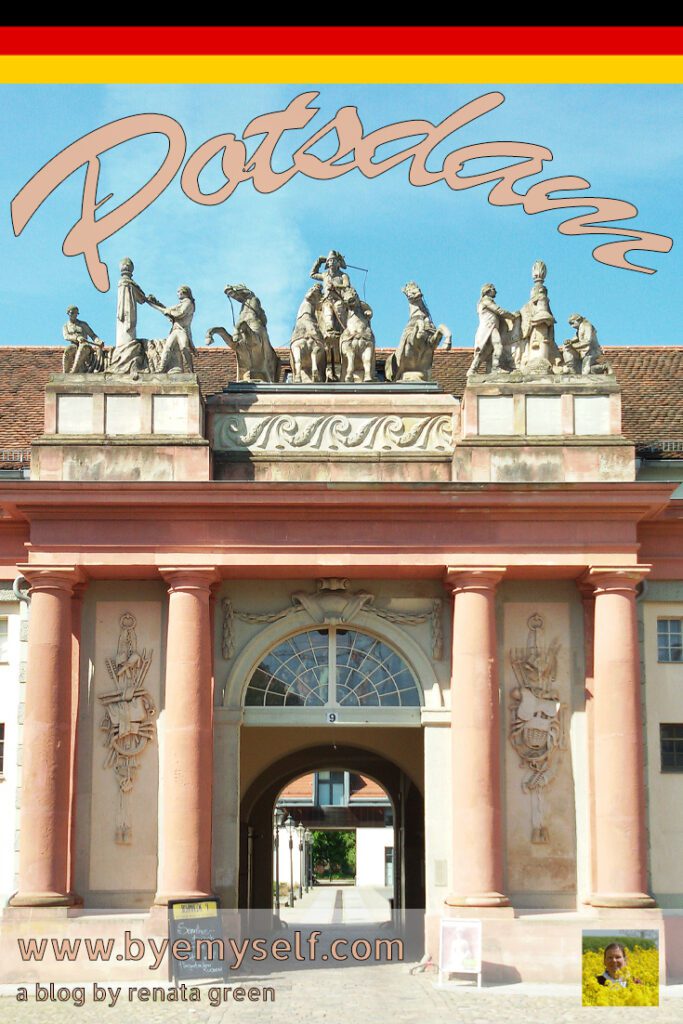
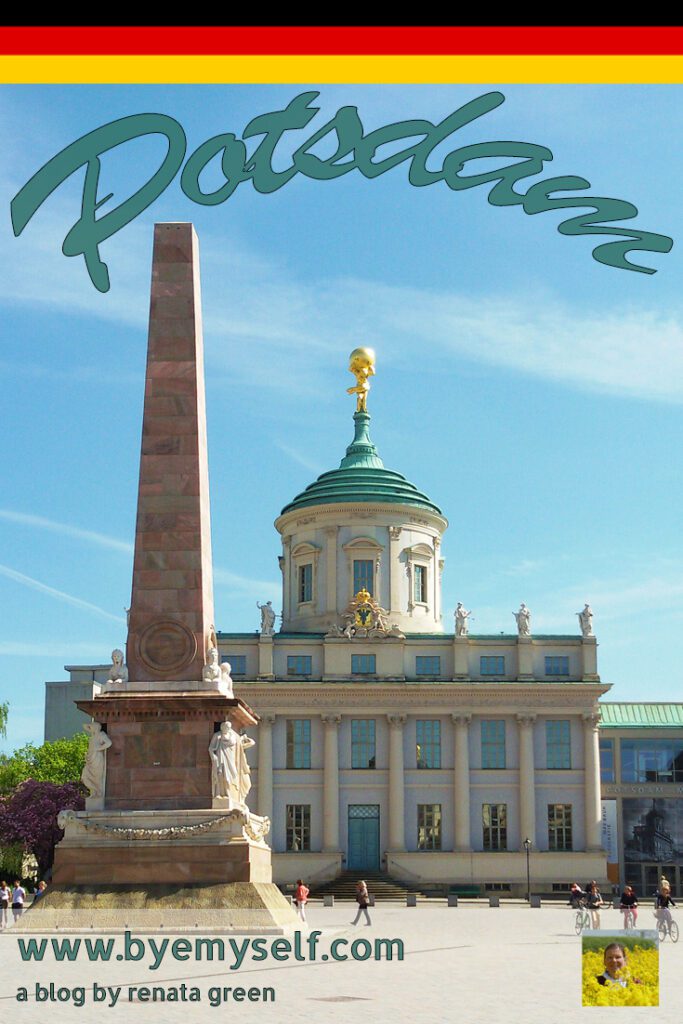

Note: I am completing, editing, and updating this post regularly – last in January 2023.
Did You Enjoy This Post? Then You Might Like Also These:
We’ll Always Have Büdelsdorf – bye:myself at the NordArt 2017
24 hours in MUNICH
Best Street Art in HAMBURG
24 hours in FRANKFURT
How to Visit the NordArt in 2022
BASEL and the Rehberger-Trail – time to wonder, time to wander
Büdelsdorf Revisited – bye:myself at the NordArt 2018
BREMEN – BIG and small. A complete city guide.
Disclaimer: *Obviously, this is an affiliate link. So if you kindly book through this page, not only do you get the best deal. I also get a small commission that helps me run this blog. Thank you so much for supporting me!
Also, Potsdam Tourismus invited me to join one of their walking tours and to visit the Sanssouci Palace.
The Tourist Office visitBerlin supported me by supplying me with a WelcomeCard,
However, all opinions on these services are mine and weren’t by any means influenced by my cooperation partners.
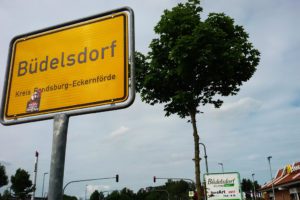
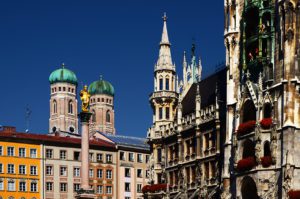



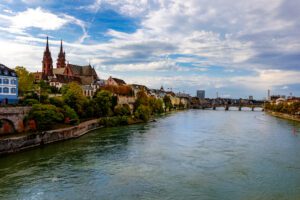
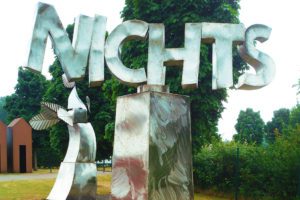

Aw, this was a really nice post. Finding the time and actual effort
to create a top notch article… but what
can I say… I put things off a whole lot and don’t
seem to get nearly anything done.
Thank you, so glad you’ve enjoyed it! 🙂
Great look at history to appreciate the beauty of a small town. Sanssouci Castle looks awesome and Frederick II really did a lot for Potsdam. Belated happy birthday to both of you and my favorite, Neil Diamond!
Hi there! This post couldn’t be written any better! Reading through this post reminds me of my previous room mate! He always kept talking about this. I will forward this article to him. Pretty sure he will have a good read. Thank you for sharing!
Thank you, so glad you like it. Potsdam is certainly worth a visit 🙂
You have done a beautiful job with this write-up. Kudos. John Wick
Thank you, I’m glad you like it 🙂
Such a great guide to Potsdam, so informative and useful. So many tips!. For sure, Sanssouci Palace is a must see. Alter Markt is also impressive. Hope to visit this city one day.
It’s just so relaxing strolling alongside all those beautiful places 🙂
Great post! Like many others I haven’t heard of Potsdam before, but certainly sounds like an interesting place to visit. I’d love to see the Italian-inspired architecture and the Sanssouci Palace.
Yes, the palace and the gardens are truly beautiful 🙂
What a gorgeous looking place. I know the name but I assumed (very wrongly assumed) it was another dare I say it, another not so pretty German city. Potsdam looks lovely and exactly the kind of town I love to visit. I’m annoyed with myself now as I spent a week in Berlin and I know I’m in the minority when I say, I’m not a huge fan of Berlin and I wish I had ventured out here ?
Right, you are not alone. While I like visiting Berlin, I would not like to live there. It’s very inspiring to visit, but not pleasant enough on a long term.
What an absolutely gorgeous town! It would be hard for me not to take 2,000 photos of the architecture, sculptures, and more. I’d LOVE to explore Potsdam on my next trip to Germany!
Haha, same here. When I visited, I didn’t have my ‘good’ camera yet. I think today, there would be not holding back 😀
Wow, what a beautiful city! I had never considered visiting Potsdam but it really does look a fantastic place. Those buildings, palaces & especially the old stables are spectacular. Those were very lucky horses! I love the idea of hiring a bike but it also looks like a number of days would be needed to do Potsdam justice, I could happily spend a day in the park. Thank you – thorough as always!
Actually, I visited only on day trips – but, obviously, spending more time does the city even more justice 🙂
Potsdam sounds like an extremely interesting place, it’s never been somewhere I have thought of travelling, but I have now added this to my list of places to go!
Yes, it has a rich history 🙂
Such a fascinating walk through the history of this part of Germany. Renting a bike sounds like a good way to get more range for exploring Potsdam. Even if we cannot cycle in Sanssouci Park. Although I can see why this park would be hard to explore with a bike. I love the variety of architecture but was intrigued by the statuary on the Film Museum and the New Palace. I can see why we might want to stay more than one day.
I think that they want to avoid that the walkers get run over by cyclists 😀 And sometimes it’s nice when rules slow you down a bit….
It’s a very interesting place to visit. I’m not mostly a fan of history but I love architecture. Very enlightening online tour guiding.
Since there is so much – international – history, I’m surprised how few people know about Potsdam.
Such an absolutely lovely town. In fact, I’m wondering how come I’ve never heard of it before as I’m the country neighbor next door! Will have to check this out when travel is allowed!
Well, now you know – so we are waiting for a visit from our neighbor 😉
Very interesting. I love to hear the history of certain kings!
Me too – and these two were particularly….colorful 😀
I love the history! I hope I can see Sanssouci Palace in Potsdam. I love the architeture.
It’s very unique, indeed. 🙂
To history-standards, it’s a huge place, indeed 😉
Wow, this isn’t a small town (hihi)! Small towns don’t have such rich history like Postdam has. I would love to visit it.
What a great place to visit! So much to see!
OMG, I can’t believe that Potsdam is a small town that is oozing with opulence! I love it and I think it will take me weeks to fully explore this small town.
It’s definitely worth the visit!
Love quaint places to explore! Thanks for being thorough, I’m sure people who are planning to go there will find the helpful!
A helpful guide is what I was aiming for 🙂
I have never heard of Potsdam, but it looks amazing. I would love to visit there.
I’m sure you would enjoy it a lot!
Thank you so much for writing an interesting piece and taking us on an exciting journey. Fab pics too by the way x
Thank you, Melanie! The place’s beauty makes photography easy 😉
Thanks for the introduction of this wonderful place in Germany that looks amazing, and there are so many places to see, look at the beautiful architecture – I think I will enjoy immensely. Knycx Journeying
Gotta love a historical tour. Thanks for sharing this! Maybe I’ll be able to visit in the future.
I felt like I was transported through time by this post. I have never heard of Frederick the Great but I feel like now I know so much about him and the little town that he and his namesakes built. It’s breathtakingly beautiful.
I’m glad I had the chance to introduce you to something you liked 🙂
Germany is definitely on my and husband’s bucket list. This is such an elaborate info and history of Postdam. I loved reading it!
I’m glad you like it. Hope you can make it there soon 🙂
There is so much good information here! I actually probably wouldn’t have ever known any of this if I hadn’t come across your blog. I will have to add this to my travel Pinterest board!
Yes, it’s surprising how few foreigners know about this place – especially since it’s so close to Berlin….
Wow so many amazing pictures, you really did this small-town justice. Germany has long since been on my travel bucket list. If I ever make it over there, I am definitely visiting, Potsdam!
Once you go, make sure to check out also the smaller towns, often they are more genuine 🙂
Definitely adding Potsdam to my travel dream list. What a rich history and beautiful place! Thank you for sharing it with us.
It is totally worth the detour when you are in Berlin or anywhere else in that area 🙂
I love reading about history and seeing historic places!!
I love the history behind everything. With all of these pictures, I feel as though I’m there!
hi
such an in-depth article and some great architecture frames that you clicked. I will still like Sans Souci Palace, Alter Markt square, Sanssouci park the best of all.
How wonderful to go on this journey with you. Personally, I especially like the journey through history.
Loved learning about him in history classes, but had no idea he played such an important role in the development of Potsdam!
Potsdam sounds like a wonderful city to explore. The architecture is captivating and I love the rich history as well.
I love how in-depth you go into your exploration of the cities you talk about. I’ve never actually heard of Potsdam before now, but now it’s another place to add to my list.
Potsdam has so much to see! I’ve wanted to visit just for the WWII history, but I see from your post there’s a palace and a beautiful domed cathedral. This is going on my bucket list!
Yes, there is really a lot to see – and lots of fascinating history.
I have never knew about this city, seems a great day trip idea while close to the capital. Great photos!
Potsdam looks like a really cool town! I love all the architecture there, and the history is really interesting.
Potsdam looks so magnificent, definitely a revelation of sorts. Could spend hours walking through its streets and be lost in time. The history of the Fredericks and how they ensured that this place achieved a stature worthy of its heritage, makes for fascinating reading.
What an interesting little town and story behind it! Love learning the history behind places like this.
I had never heard of this town or this story until now! Thank you for sharing as I love learning little bits of history
I am very suprised how few people have heard of it since when it comes to European history, it's quite a big deal – also for the conference after WWII when the division of Germany was agreed.
I have never even heard of Potsdam before this post. It sounds like such a wonderful town. Full of a rich history and beautiful architecture. Love all the pictures, absolutely gorgeous! Thank you for sharing?
I love the brief history you explained as it gave more meaning to this small town as I continued reading your post. I will definitely remember now that Frederick was born the same day as you and Neil Diamond 🙂
We spend a lot of time in Berlin and we absolutely LOVE Potsdam … so easy to get to by the train. One thing we have missed so far and will have to do now when we go back is visit the Russian quarter Alexandrowka. Can't believe we have managed to miss that one. Love your photos advice! Very helpful.
I love this so much! I love getting to know a little history about past rulers. It's amazing that his sitting room is still there. Really helps take you back where you could imagine what he could have been doing. I love getting to know about history like this. Gives me some goosebumps!
this little gem is not far away from me , added to my "places to visit " ! thank you for your story, great read
I loved Potsdam too, was there last year and was impressed with such beautiful buildings and details around the area. It's a great day trip from Berlin!
First thing I noticed was that you got a beautiful sunny day to explore Potsdam. Last when we were in Germany someone did mention Potsdam but we decided to give it a miss as even Berlin was not in our schedule then. Next time we plan to do Berlin and other parts which we missed last time. I like your idea of posting pictures of domes. 🙂
I cant believe a small town can offer so much! I love the history and the views are magnificent!
wow, rich in information, i love it. thank you for sharing the history and beauty of Potsdam. it is a beautiful place
I am loving the history here. The photos look nice. The buildings are very beautiful.
Such a fantastic informative post. I love that music room it looks amazing. I'd never heard of Potsdam before I read this post but it was interesting to discover a new place through your post.
Wow what a brilliant post this was. Potsdam sounds amazing and bathed in so much history. It really looks like a beautiful place!
I have never been to Potsdam, clearly, I am missing a lot. This place is filled with so much history and culture. The architecture is also breathtaking. I enjoyed looking at the pictures and reading more about it in this post, thank you so much for that!
I hadn’t heard of Potsdam, so much history! Sanssouci Palace and park look beautiful and I love that Alter Markt isn’t crowded. Great tip on the WelcomeCard
I like places like Potsdam, so much of history associated with the place. You have done commendable amount of research for this post. Very informative.
I’m always fascinated by brick gables. The shopping street is also so lively. The Sanssouci Palace has really weird “gates”? Great destinations. Nice tip on the trains as well.
There is so much great information in here and I so appreciate the history at the beginning. Both of the Frederick's sound like fascinating fellas, very opposite too. I'd love to see the Dutch part of town and the Russian cottages.
Quite a lot of useful information you have packed in to this post! I love a walkable city, and Potsdam looks like it would fit that description. I love ambling around city parks and museums and also just observing people as they go about their daily errands. And look how clean everyplace seems!
Your pictures are stunning. The King of Prussia sounds interesting. This was such a through post and I loved seeing all the different architecture.
This looks like such a charming town with a fascinating history. I spent a few days in Berlin, but unfortunately did not have time to get out of the city. I would love to go back and explore more of the surroundings.
It can be so easy to get caught up in big cities that we forget about the suburbs. I know I am guilty of this myself. But as you've shown, there is so much history and beautiful sights to be seen just a little further out.
I have to admit, I was a bit lukewarm when it came to Berlin (I know! I think I'm the only traveler to feel that way). But Potsdam looks so much more my speed. SO pretty and so many cool museums – also now whenever I hear Neil Diamond I'm gonna think of you.
Potsdam looks such an interesting town with all the history behind her. The architecture is also so nice. Alexandrowka is also so intriguing. I loved your narrative about King Frederick. Liked reading through the post!
You had me at the architecture. It's magnificent, isn't it? I wasn't expecting to see a Russian homestead in Potsdam but there it is! I love how you humorously thread Frederick's "presence" throughout the narrative. Enjoyed this piece a lot!
As always, thanks for your super thorough posts. The architecture is beautiful! Some unexpected things for me are the thriving film scene and the Russian Quarter. Bookmarked for a future visit to Germany!
I had no idea there was such a film presence and history in Potsdam! (I work in the film industry in LA, so am very intrigued by this.) I will have to look up more of the films that were made there. I'm also impressed with the influx of renovations that have been made recently to the buildings. They look spectacular in your photos, I imagine they are even moreso in person!
We spent some time in Germany but never made it to the Berlin area. Hope to go back and see it someday. The architecture and paintings alone draw me. I guess you will never forget Frederick II birthday! He sounds a bit like a Renaissance man – what do you think? I would love to see the Sanssouci castle.
Great photos! Great tour! So complete!
Looks like a really charming town, the architecture is fascinating! I love to travel around Germany and this is one of the things that I need to put on my bucket list for sure!
Wow! This is so elaborate and certainly helps to understand the town! The architecture and details around this town are amazing! It looks like such a lovely place to visit!